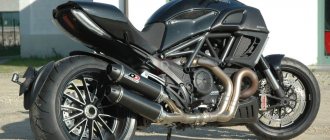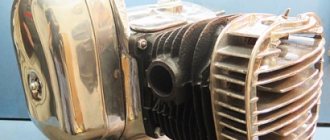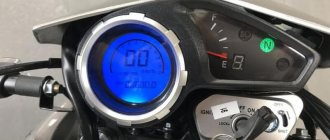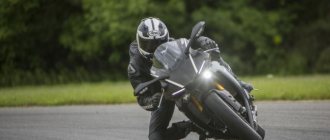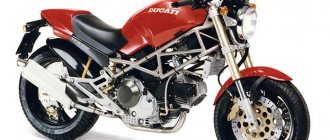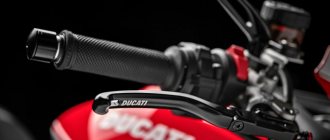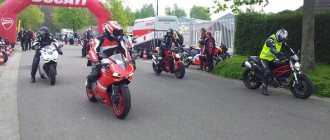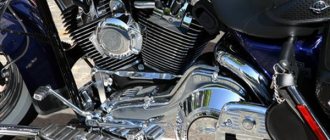If there is a motorcycle brand in Europe that almost everyone knows, it is Ducati. These are the motorcycles that have made many riders champions. They performed at many of the most prestigious world and European championships.
Against the backdrop of the ever-leading Germany, Italian manufacturers usually felt secondary. With the era of Japanese dominance, problems arose among the Germans themselves, who, although they created the world's first motorcycle, were unable to retain the palm.
Among all modern European brands, only BMW (+Husqvarna), Aprillia and Ducati were able to oppose something to Japanese technology. But this happened in relatively recent times.
History of the brand
The company was founded back in 1926 by two Italian brothers Adriano and Marcello Ducati. Initially, the company was engaged in the production of radio equipment and only by the 50s of the last century achieved popularity in the motorcycle environment. After the first velomobile, Ducati released the first production model, the Cruiser, in 1952. With each new model, the company increased its capacity and increased production volumes. But in the 1980s, Ducati fell on hard times. The Cagiva company buys out Italian production and begins producing Enduro motorcycles. Ducati motorcycles have lost their charm and zest.
But since 1985, things have picked up again. Under the leadership of the new chief designer, the legendary 916 and Monster models went into production. In 2012, the brand was bought by the AUDI AG corporation, under whose wing production has been successfully developing to this day.
Working hours
A guided tour of the museum is usually booked in advance and can be taken on the following days:
Monday to Friday: 9.15, 11.00, 13.45, 15.30
Duration of the excursion
around the factory and museum: 1.5 hours.
On Saturday there is a tour of the museum only.
Excursion times: 10.00, 11.00, 12.00
A tour of the museum lasts about 30 minutes.
Meeting point
— before entering the enterprise. Late arrivals are not allowed onto the premises.
Closed:
Sundays, Easter holidays, summer holiday season (to be confirmed), Christmas and Italian public holidays (April 25, May 1, June 2, November 1, December 8).
Description of motorcycles
Diavel is the second ever cruiser from . The world premiere of the model took place in 2010 in Milan. This motorcycle was created specifically to conquer a new market segment. The fact is that since 1990, there has not been a single cruiser in the Ducati lineup. The Diavel has a 1.2 cm3 engine with 162 horsepower and liquid cooling. The model has two types of cladding - aluminum or carbon. The second option gives the motorcycle a sportier feel, reducing its weight by as much as 3 kilograms. The design of the model will not leave anyone indifferent. Graceful lines and swift profile more and more resemble the devil himself.
The second model in the Ducati line is the Streetfighter. This bike combines all the best developments of the company in its history. The L-Twin engine, excellently tuned suspension, and excellent braking system should leave only the most positive driving impressions. This motorcycle is available in 2 versions: S and 848.
Multistrada is a universal model from Ducati. The motorcycle, the price of which does not exceed any other model, combines 4 directions, as can be judged by its name. The “urban” mode is intended for city use, the “sport” mode is for traveling on highways and racing on asphalt surfaces, the “enduro” mode is useful for off-road use, and the “tourism” mode is for comfortable trips.
Monster is the oldest model. The first generation of "Monster" was released more than 20 years ago. The new model range includes 6 modifications of this bike. It combines new technologies and sophisticated modern design, thanks to which it sets the direction for the development of the entire brand.
Superbike is the fastest and most controllable bike. In terms of technical characteristics, it surpasses all other Ducati motorcycles. There are 4 modifications of the “Superbike” in the 2021 model range.
Hypermotard is the embodiment of all modern technologies. It perfectly combines power and handling with comfort for long and medium trips. All Ducati motorcycles are gradually switching to the technologies used in the Hypermotard.
DUCATI from the inside - factory tour in Bologna
Since March 1946, DUCATI has produced its motorcycles in the world's only plant in Bologna, although since the middle of the last century the company has significantly increased both production volumes and the number of models. 55,000 motorcycles are produced annually; at peak production, 500 workers work on the devices. The company's headquarters is located in the same place, in Bologna, in the Borgo Panigale area, on Via Antonio Cavalieri Ducati (the three Cavalieri brothers founded the company in 1926, and their father was called Antonio).
DUCATI has offices around the world and employs a further 480 people, including 120 in the DUCATI Corse racing department. They are working to ensure that the rivals of factory team drivers Jorge Lorenzo and Andrea Dovizioso and the DUCATI satellite teams remain far behind the blood red bikes. Unfortunately, entry into the DUCATI Corse building is prohibited to everyone except employees, but excursions are organized to the DUCATI factory, and you can watch how specialists create an Italian miracle of technology from original parts.
Future stars
The first place you come to at the DUCATI factory is DESI, the company's educational center. Every year the company selects 26 lucky students aged 16–18 from Bologna and pays for their two years of education. Students learn to operate CNC machines and gain other useful skills that will be useful to them in machine-building plants. While studying, young people receive a scholarship of 600 euros. Italians consider working for DUCATI very prestigious, and the company invests heavily in finding and training talented specialists.
Pictured: DESI classroom
Raw materials
Just behind DESI is the machining shop, where raw parts such as connecting rods and camshafts are finished on machines. This workshop is the only one at the plant that operates 24 hours a day, 7 days a week. All spare parts are supplied in the form of raw materials: about 60% come from Italian companies, another 10% are brought from EU countries, the remaining parts come from other countries. For example, the weight of the Panigale camshaft, which just arrived from the factory at the DUCATI plant, is a little more than a kilogram. At the factory it is ground, holes are drilled in it, milled, and then primed. The weight of the part after all technological processes is 410 grams. After processing, all motorcycle parts are sent to the “Supermarket”.
The section with such an unusual name really resembles a large store: there workers sort all the spare parts, which will then end up at work stations along the production line. The parts are placed in special containers where they are stored until they are installed on the motorcycle. Every assembler knows: if even one nut falls out of the container, the work of the entire team can go down the drain. In the 90s, production was chaotic, with technicians taking parts directly from the assembly line. The result of this approach was a large number of errors, so the build quality suffered and the production time of the motorcycle increased.
Engine pre-assembly
Before the engine hits the conveyor belt, workers separate its parts into two containers. The first contains the crankshafts and pistons, and the second contains the engine itself with all the associated supports. This saves time and at this stage the engine is given unique identification numbers.
In the photo: assembly workshop of the DUCATI plant
At the DUCATI plant there are three conveyors with engines. One assembles Superquadro power units, which are installed, for example, on the Panigale 1299 model.
On another line, engines are assembled for the Hypermotard, Monster, SuperSport and Scrambler models.
On the third assembly line, workers assemble engines for the Diavel and Multistrada.
Each zone is divided into 2 production lines, each with two specialists working on two engines simultaneously. During work, employees do not exchange engines; each one makes his own. Thus, the workflow eliminates the need to perform the same manipulations with a separate engine. The first part of the Superquadro engine assembly takes an hour, as it is more complex than the units in the Scrambler or Multistrada models - the engines of these models require 30 minutes to assemble. After the first stage, the engines are transferred further along the belt. The Superquadro and Multistrada engines need another hour to be fully assembled, while the Scrambler engine will be ready in 45 minutes.
In the photo: assembly workshop of the DUCATI plant
Each engine contains about five hundred parts. DUCATI debunks the myth of only male engine assemblers - many women work at this stage of production. Immediately after assembly, each unit is tested, it is accelerated to 2,500 rpm, and if something goes wrong, the engine is immediately sent to the “Hospital”. This is where specialists re-evaluate the engine and fix any problems identified. In the 90s, 5–6% of all engines ended up being overhauled, and now their number is less than one percent—the modernization of production has been beneficial.
Motorcycle assembly lines
DUCATI produces 34 motorcycle models: the Monster, SuperSport and XDiavel are assembled on one assembly line, the Scrambler is assembled on another, and the Panigale appears on a third. On these lines, the engine is already installed on a frame prepared for painting; for further work, a ready-made motorcycle frame is needed. Along the conveyor line, the future bike moves towards the completion stage, two workers work on it at the same time, and it takes them 22 minutes. During peak production season, 350 motorcycles roll off the assembly line daily. After assembly, they are sent to the testing site.
In the photo: assembly of a DUCATI motorcycle
Ending station
Immediately after assembly, the bike is sent for its first test, where the level of harmful emissions is measured before the main test. DUCATI has about 200 variations of motorcycle system settings, each used for a particular country - each state has its own laws on environmental protection. At this stage, the required engine control unit is installed. Immediately after these manipulations, the motorcycle goes to the dyno, where all its systems are tested: ABS, traction control, quickshifter, gearbox and engine - everything must work flawlessly. The test on the stand takes five minutes and does not in any way harm the future running-in of the motorcycle - the engine is accelerated to 5 thousand revolutions per minute, and the wheel speed does not exceed 100 km/h. If everything goes well, the motorcycle is ready for release. To completely assemble a DUCATI motorcycle, you need 10–14 hours - this is time without the initial processing of raw parts.
In the photo: assembly workshop of the DUCATI plant
Delivery
There is not enough space in the production area to store all the motorcycles produced for a long time. Therefore, every day 350 devices are sent to the warehouse, from where the next day they will go to one of 783 official dealers in 90 countries. Including the Moscow dealership DUCATI - MOTORRIKA at the address: Moscow, st. Krylatskaya, 14, where the bike will be carefully handed over to a happy client - Ducatisti, as the manufacturer affectionately calls it.
DUCATI in numbers
1200 - number of employees at the Bologna plant
500 - number of employees involved in work on the conveyor
30% - percentage of women in production
120 – number of employees in the racing department of DUCATI Corse
350 - the number of motorcycles rolling off the assembly line during the peak production season
55 thousand - the number of DUCATI motorcycles produced in 2016
120 minutes - Superquadro engine assembly time
500 - number of parts in a DUCATI engine
783 – number of dealers worldwide
Bottom line
Ducati is a motorcycle brand with a unique and interesting history. Despite all the difficulties, currently under the management of Audi AG the company has a full-fledged diverse model range. Among the motorcycles produced by the company, you can find both road sport bikes and comfortable cruisers for travel. You can follow the latest updates to the model range and modifications of motorcycles through the website of the official representative of Ducati-Russia.
The company's cheapest motorcycle at the moment is the Monster in its simplest modification for 800 thousand rubles. The most expensive model has a price tag of 6 million 200 thousand rubles. From this we can conclude that the company is trying to produce motorcycles for a wide variety of consumers.
